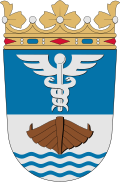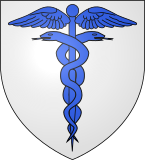কেডুচিয়াছ


কেডুচিয়াছ (☤; /kəˈdjuːʃəs[unsupported input]-siəs/; লেটিন: cādūceus , from গ্ৰীক: κηρύκειον kērū́keion "হেৰাল্ডৰ লাখুটি, বা ষ্টাফ")[টোকা 2] হৈছে গ্ৰীক পৌৰাণিক কাহিনীত হাৰ্মিচ আৰু গ্ৰীক-ইজিপ্তৰ পৌৰাণিক কাহিনীত হাৰ্মিছ ট্ৰাইছমেগিষ্টাছে কঢ়িয়াই অনা লাখুটি। একেটা লাখুটিকে সাধাৰণতে হেৰাল্ডসকলেও বহন কৰিছিল, উদাহৰণস্বৰূপে হীৰাৰ দূত আইৰিছেও বহন কৰিছিল। ই দুটা সাপৰ দ্বাৰা সংযুক্ত এটা চুটি লাখুটি, কেতিয়াবা ইয়াৰ ওপৰত ডেউকাও থাকে। ৰোমান আইকন’গ্ৰাফীত ইয়াক প্ৰায়ে দেৱতাসকলৰ দূত বুধৰ বাওঁহাতত কঢ়িয়াই নিয়া অৱস্থাত চিত্ৰিত কৰা হৈছিল।
কিছুমান বিৱৰণে প্ৰকাশ কৰে যে কেডুচিয়াছৰ আটাইতকৈ পুৰণি জ্ঞাত চিত্ৰকল্পৰ শিপা মেছ’পটেমিয়াত চুমেৰিয়ান দেৱতা নিংগিছজিদাৰ সৈতে আছে; তেওঁৰ প্ৰতীক, চাৰিওফালে দুটা সাপ জড়িত হৈ থকা এটা লাখুটি, খ্ৰীষ্টপূৰ্ব ৪০০০ চনৰ পৰা খ্ৰীষ্টপূৰ্ব ৩০০০ চনলৈকে।[3]
প্ৰতীকী বস্তু হিচাপে ই হাৰ্মিছ (বা ৰোমান বুধ) আৰু সম্প্ৰসাৰণৰ দ্বাৰা দেৱতাৰ সৈতে জড়িত ব্যৱসায়, বৃত্তি বা কাম-কাজক প্ৰতিনিধিত্ব কৰে। পৰৱৰ্তী প্ৰাচীন কালত কেডুচিয়াছে বুধ গ্ৰহক প্ৰতিনিধিত্ব কৰা জ্যোতিষ প্ৰতীকৰ ভিত্তি প্ৰদান কৰিছিল। এইদৰে জ্যোতিষী, ৰসায়ন আৰু জ্যোতিৰ্বিজ্ঞানত ইয়াৰ ব্যৱহাৰৰ জৰিয়তে ই একে নামৰ গ্ৰহ আৰু মৌলিক ধাতুটোক বুজাবলৈ সক্ষম হৈছে। কোৱা হয় যে সেই লাখুটিডালে শুই থকাজনক জগাই তুলিব আৰু জাগ্ৰতজনক শুবলৈ পঠিয়াই দিব। যদি মৃত্যুমুখত পৰাৰ ওপৰত প্ৰয়োগ কৰা হয়, তেন্তে তেওঁলোকৰ মৃত্যু কোমল আছিল; যদি মৃতসকলৰ ওপৰত প্ৰয়োগ কৰা হয়, তেন্তে তেওঁলোক পুনৰ জীৱিত হৈছিল।[4]
বুধ আৰু হাৰ্মিছৰ সৈতে ইয়াৰ সংযোগৰ সম্প্ৰসাৰণৰ দ্বাৰা কেডুচিয়াছ বাণিজ্য আৰু আলোচনাৰ এক স্বীকৃতিপ্ৰাপ্ত প্ৰতীকও, দুটা ক্ষেত্ৰ য’ত সুষম বিনিময় আৰু পাৰস্পৰিকতাক আদৰ্শ হিচাপে স্বীকৃতি দিয়া হয়।[5][6][7] এই সংযোগ প্ৰাচীন, আৰু প্ৰাচীন যুগৰ পৰা আধুনিক সময়লৈকে সামঞ্জস্যপূৰ্ণ।[8][9] কেডুচিয়াছক ছপাক প্ৰতিনিধিত্ব কৰা প্ৰতীক হিচাপেও ব্যৱহাৰ কৰা হয়, পুনৰ বুধৰ বৈশিষ্ট্যসমূহৰ দ্বাৰা সম্প্ৰসাৰণৰ কৰা হয় (এই ক্ষেত্ৰত লিখা আৰু বাকপটুতাৰ সৈতে জড়িত)।
যদিও মাত্ৰ এটা সাপ থকা আৰু কেতিয়াও ডেউকাৰে চিত্ৰিত কৰা ৰড অৱ এছক্লেপিয়াছ চিকিৎসাৰ পৰম্পৰাগত আৰু অধিক ব্যৱহৃত প্ৰতীক, কেডুচিয়াছ কেতিয়াবা স্বাস্থ্যসেৱা সংস্থাসমূহে ব্যৱহাৰ কৰে। 'কেডুচিয়াছ' মূলতঃ বাণিজ্য আৰু অন্যান্য অচিকিৎসা প্ৰতীকৰ প্ৰতীক বুলি ধৰি ল'লে বহুতো স্বাস্থ্যসেৱা পেছাদাৰীয়ে এই ব্যৱহাৰক অসন্মতি প্ৰকাশ কৰে।[10]
ঐতিহাসিক প্ৰাচীনতা
[সম্পাদনা কৰক]| ঐতিহসিক চিত্ৰকল্পত কেডুচিয়াছ | |||||||||
| |||||||||
পৌৰাণিক কাহিনী
[সম্পাদনা কৰক]হাৰ্মিছৰ প্ৰতি হোমেৰিক গীতটোত বৰ্ণনা কৰা হৈছে যে কেনেকৈ তেওঁৰ আঢ়ৈ বছৰীয়া ভাতৃ এপ’লোৱে হাৰ্মিছৰ কচ্ছপৰ খোলাৰ পৰা নিৰ্মিত লাইয়াৰৰ পৰা হাৰ্মিছৰ সংগীতৰ দ্বাৰা মোহিত হৈছিল, যিটো হাৰ্মিছে তেওঁক সদয়ভাৱে দিছিল। বিনিময়ত এপ’ল'ৱে বন্ধুত্বৰ ইংগিত হিচাপে হাৰ্মিছক কেডুচিয়াছ দিলে। এইদৰে সাপৰ সৈতে থকা সম্পৰ্কই হাৰ্মিছক এপ'ল'ৰ সৈতে সংযোগ কৰে, কিয়নো পিছলৈ সাপটোক "এপ'ল'ৰ পুত্ৰ" এছক্লেপিআছৰ সৈতে জড়িত কৰা হয়।[11]
এপ’ল’ৰ সৰ্পৰ সৈতে সম্পৰ্ক পুৰণি ভাৰত-ইউৰোপীয় অজগৰ-হত্যাকাৰী মটিফৰ ধাৰাবাহিকতা। উইলহেম হাইনৰিখ ৰ'চাৰে (১৯১৩) আঙুলিয়াই দিছিল যে হাৰ্মিছ আৰু এছক্লেপিয়াছ উভয়ৰে এটা বৈশিষ্ট্য হিচাপে সাপটো "ডেলফিত পাইথন নামেৰে জনাজাত প্ৰাক-ঐতিহাসিক অৰ্ধ-চ্থনিক সাপ নায়ক"ৰ এটা ভিন্নতা, যাক ধ্ৰুপদী পৌৰাণিক কাহিনীত এপ'লোৱে হত্যা কৰে।[12]
কেডুচিয়াছৰ উৎপত্তিৰ এটা গ্ৰীক মিথ তিৰেছিয়াছৰ কাহিনীৰ অংশ,[13] যিয়ে দুটা সাপক সংগম কৰি থকা দেখি নিজৰ লাখুটিৰে মাইকীজনীক হত্যা কৰিছিল। তিৰেছিয়াছক লগে লগে নাৰীলৈ ৰূপান্তৰিত কৰা হয়, আৰু সাত বছৰৰ পাছত মতা সাপটোৰ সৈতে এই কাৰ্য্য পুনৰাবৃত্তি কৰিবলৈ সক্ষম নোহোৱালৈকে তেওঁ তেনেকৈয়ে থাকিল। এই লাখুটিটো পিছলৈ ইয়াৰ ৰূপান্তৰকাৰী শক্তিৰ লগতে হাৰ্মিছ দেৱতাৰ দখলত আহে।
Another myth suggests that Hermes (or Mercury) saw two serpents entwined in mortal combat. Separating them with his wand he brought about peace between them, and as a result the wand with two serpents came to be seen as a sign of peace.[2]
In Rome, Livy refers to the caduceator who negotiated peace arrangements under the diplomatic protection of the caduceus he carried.[14]
আইকন'গ্ৰাফী
[সম্পাদনা কৰক]In some vase paintings ancient depictions of the Greek kerukeion are somewhat different from the commonly seen modern representation. These representations feature the two snakes atop the staff (or rod), crossed to create a circle with the heads of the snakes resembling horns. This old graphic form, with an additional crossbar to the staff, seems to have provided the basis for the graphical sign of Mercury (☿) used in Greek astrology from Late Antiquity.[15]
উৎপত্তি আৰু তুলনামূলক পৌৰাণিক কাহিনী
[সম্পাদনা কৰক]
কেৰুকেয়ন শব্দটোৱে যিকোনো হেৰাল্ডৰ কৰ্মচাৰীক বুজাইছিল, বিশেষকৈ হাৰ্মিছৰ সৈতে জড়িত হোৱাটো বাধ্যতামূলক নহয়।[16]
হাৰ্মিছৰ পূজাৰ ওপৰত কৰা অধ্যয়নত লুইছ ৰিচাৰ্ড ফাৰ্নেলে (১৯০৯) ধৰি লৈছিল যে এই দুটা সাপ কেৱল হেৰাল্ডসকলে নিজৰ লাখুটি হিচাপে ব্যৱহাৰ কৰা গোহালিৰ গোহালিৰ অলংকাৰৰ পৰাই গঢ় লৈ উঠিছে।[17] এই মতবাদক পৰৱৰ্তী লেখকসকলে প্ৰাচীন নিকট পূবৰ সমান্তৰাল আইকনগ্ৰাফীলৈ আঙুলিয়াই নাকচ কৰিছে। এইটো যুক্তি দিয়া হৈছে যে দুটা সাপে সংলগ্ন কৰা লাখুটি বা লাখুটিডাল নিজেই প্ৰাক-নৃতাত্ত্বিক যুগৰ কোনো দেৱতাক প্ৰতিনিধিত্ব কৰিছিল। হাৰ্ম বা প্ৰিয়াপাছৰ দৰেই ইও এইদৰে ধ্ৰুপদী যুগৰ নৃৰূপী হাৰ্মিছৰ পূৰ্বসূৰী হ’ব।[18]
প্ৰাচীন নিকট পূব
[সম্পাদনা কৰক]

William Hayes Ward (1910) discovered that symbols similar to the classical caduceus sometimes appeared on Mesopotamian cylinder seals. He suggested the symbol originated some time between 3000 and 4000 BC, and that it might have been the source of the Greek caduceus.[19] A.L. Frothingham incorporated Dr. Ward's research into his own work, published in 1916, in which he suggested that the prototype of Hermes was an "Oriental deity of Babylonian extraction" represented in his earliest form as a snake god. From this perspective, the caduceus was originally representative of Hermes himself, in his early form as the Underworld god Ningishzida, "messenger" of the "Earth Mother".[20] The caduceus is mentioned in passing by Walter Burkert[21] as "really the image of copulating snakes taken over from Ancient Near Eastern tradition".
In Egyptian iconography, the Djed pillar is depicted as containing a snake in a frieze of the Dendera Temple complex.
In the biblical Books of Kings (সাঁচ:Bibleverse; written c. 550 BCE[22]), the Nehushtan (Hebrew: נחשתן Nəḥuštān সাঁচ:IPA-he) is a derogatory name given to a bronze serpent on a pole first described in the Book of Numbers which God told Moses to erect so that the Israelites who saw it would be protected from dying from the bites of the "fiery serpents", which God had sent to punish them for speaking against Him and Moses (সাঁচ:Bibleref2).
ভাৰত
[সম্পাদনা কৰক]The caduceus also appears as a symbol of the punch-marked coins of the Maurya Empire in India, in the third or second century BC. Numismatic research suggest that this symbol was the symbol of the Buddhist king Ashoka, his personal "Mudra".[23] This symbol was not used on the pre-Mauryan punch-marked coins, but only on coins of the Maurya period, together with the three arched-hill symbol, the "peacock on the hill", the triskelis and the Taxila mark.[24] It also appears carved in basalt rock in few temples of western ghats.
প্ৰাথমিক আধুনিক ব্যৱহাৰ
[সম্পাদনা কৰক]During the early modern period, the caduceus was used as a symbol of rhetoric (associated with Mercury's eloquence).[25]
-
Engraving by Hendrik Goltzius (1558–1617)
-
La Retorique (1633–35)
-
Allegory of Rhetoric (1650)
বৰ্তমান ব্যৱহাৰ
[সম্পাদনা কৰক]বাণিজ্যৰ প্ৰতীক
[সম্পাদনা কৰক]A simplified variant of the caduceus is to be found in dictionaries, indicating a "commercial term" entirely in keeping with the association of Hermes with commerce. In this form the staff is often depicted with two winglets attached and the snakes are omitted (or reduced to a small ring in the middle).[5] The Customs Service of the former German Democratic Republic employed the caduceus, bringing its implied associations with thresholds, translators, and commerce, in the service medals they issued their staff. The caduceus is also the symbol of the Customs Agency of Bulgaria and of the Financial Administration of the Slovak Republic[26] (Tax and Customs administration). The emblems of Belarus Customs[27][28] and China Customs[29] are a caduceus crossing with a golden key. The emblem of the Federal Customs Service of Russia has a caduceus crossing with a torch on the shield. The coat of arms of Kyiv National University of Trade and Economics of Ukraine has two crossed torches surmounted by a caduceus on the shield.
ৰড অৱ এছক্লেপিয়াছৰ সৈতে বিভ্ৰান্তি
[সম্পাদনা কৰক]সাঁচ:Caduceus confusion summary
কম্পিউটাৰ ক'ডিং
[সম্পাদনা কৰক]কম্পিউটাৰত প্ৰস্তুত কৰা নথিপত্ৰত ব্যৱহাৰৰ বাবে, চিহ্নটোৰ ইউনিক’ডত ক’ড পইণ্ট থাকে, U+2624 ☤ caduceus ত. কেডুচিয়াছৰ বাবে U+1F750 🝐 ৰসায়ন চিহ্নত সংকেত কৰা এটা ৰসায়ন চিহ্নও আছে। [চিহ্নটো কেনেকৈ সুমুৱাব লাগে তাৰ বিষয়ে তথ্যৰ বাবে, ইউনিক'ড ইনপুট চাওক (বা ইয়াক প্ৰত্যক্ষভাৱে কপি/পেষ্ট কৰক)।] এই চিহ্নসমূহ সকলো ফন্টত প্ৰদান কৰা হোৱা নাই, বিশেষকৈ পুৰণিবোৰত।
জাতীয় পতাকা আৰু পতাকা
[সম্পাদনা কৰক]একাধিক জাতীয় পতাকা আৰু পতাকাত এই প্ৰতীকটো চিত্ৰিত কৰা হৈছে।
| Caduceus in coats of arms and flags | ||||||||||||||||||||||||||||||
| ||||||||||||||||||||||||||||||
লগতে চাওক
[সম্পাদনা কৰক]
টোকাসমূহ
[সম্পাদনা কৰক]উৎসসমূহ
[সম্পাদনা কৰক]- Friedlander, Walter J. (1992). The Golden Wand of Medicine: A History of the Caduceus Symbol in Medicine. Greenwood Press. ISBN 978-0-313-28023-8..
- Tyson, Stuart L. (1932). "The Caduceus". The Scientific Monthly খণ্ড 34 (6): 492–498.
তথ্যসূত্ৰসমূহ
[সম্পাদনা কৰক]- ↑ Liddell and Scott, Greek–English Lexicon
- ↑ 2.0 2.1 Tyson 1932.
- ↑ Gary Lachman, "The Quest for Hermes Trismigestus", 2011, Chapter 3, p. x.
- ↑ William Godwin (1876). "Lives of the Necromancers". পৃষ্ঠা: 37. https://archive.org/details/livesnecromance04godwgoog.
- ↑ 5.0 5.1 "Miscellaneous Symbols". Unicode Consortium. https://www.unicode.org/charts/nameslist/n_2600.html. "U+269A ⚚ staff of hermes signifies a commercial term or commerce"
- ↑ Friedlander 1992.
- ↑ Howey, M. Oldfield (1955). The Encircled Serpent: A Study of Serpent Symbolism in All Countries And Ages. প্ৰকাশক New York. পৃষ্ঠা. 77. "In modern times the caduceus figures as a symbol of commerce, since Mercury is the god of commerce"
- ↑ Bonnefoy, Yves, ed (1992). Roman and European Mythologies. University of Chicago Press. পৃষ্ঠা. 135. "The name of the god Mercury cannot be disassociated from the word merx, which means merchandise. Such was the sentiment of the ancients."
- ↑ Bakich, Michael E. (2000). The Cambridge Planetary Handbook. Cambridge University Press. পৃষ্ঠা. 85. "Mercury was the Roman name for the Greek god Hermes. His Latin name was apparently derived from merx or mercator, a merchant."
- ↑ উদ্ধৃতি ত্ৰুটি: অবৈধ
<ref>টেগ;Engleনামৰ refৰ বাবে কোনো পাঠ্য প্ৰদান কৰা হোৱা নাই - ↑ Deldon, Anne McNeely (1996). Mercury rising: women, evil, and the trickster gods. Spring Publications. পৃষ্ঠা. 90. ISBN 978-0-88214-366-8. "Homer tell us that Hermes' caduceus, the golden wand, was acquired by Hermes from Apollo in exchange for the tortoise-lyre; later the caduceus changed hands again from Hermes to Apollo's son, Asclepius."
- ↑ S. Davis (citing W. H. Roscher, Omphalos (1913)) (1953). "Argeiphontes in Homer – The Dragon-Slayer". Greece & Rome খণ্ড 22 (64): 33–38. doi:10.1017/S0017383500011712.
- ↑ Blayney, Keith (September 2002). "The Caduceus vs the Staff of Asclepius". http://drblayney.com/Asclepius.html। আহৰণ কৰা হৈছে: 2007-06-15.
- ↑ Livy: Ab Urbe Condita Libri, 31,38,9–10
- ↑ "Signs and Symbols Used In Writing and Printing", p 269, in Webster's New Twentieth Century Dictionary of the English Language, unabridged, New York, 1953. Here the symbol of the planet Mercury is indicated as "the caduceus of Mercury, or his head and winged cap".
- ↑ Oxford Classical Dictionary, third edition, ed. Hornblower and Spawforth, s.v. "Hermes".
- ↑ Farnell, The Cults of the Greek States, vol. 5, p. 20, cited in Tyson 1932:494.
- ↑ A. L. Frothingham (1916). "Babylonian Origin of Hermes the Snake-God, and of the Caduceus I". American Journal of Archaeology খণ্ড 20, No. 2 (April–June, 1916) (2): 175–211. doi:10.2307/497115. Frothingham characterizes Farnell's simplistic view of the origin of the symbol as a "frivolous and futile theory".
- ↑ William Hayes Ward, The Seal Cylinders of Western Asia, Washington, 1910
- ↑ A.L. Frothingham, "Babylonian Origins of Hermes the Snake-God, and of the Caduceus", in American Journal of Archaeology, Vol. 20, No. 2, pp. 175–211
- ↑ Burkert, Greek Religion 1985: II.2.8, p. 158; Burkert notes H. Frankfort, in Iraq, 1 (1934:10) and E.D. van Buren, in Archiv für Orientforschung, 10 (1935/36:53-65).
- ↑ Grabbe, Lester L. (2016-12-01) (en ভাষাত). 1 & 2 Kings: An Introduction and Study Guide: History and Story in Ancient Israel (1 সম্পাদনা). T&T Clark.
- ↑ Damodar Dharmanand Kosambi, Indian Numismatics, Orient Longman, New Delhi 1981, p. 73 (online).
- ↑ Kailash Chand Jain, Malwa Through the Ages. From the Earliest Time to 1305 A.D., Motilal Banarsidass, Delhi et al. 1972, p. 134 (online).
- ↑ Noldus, B.; Roding, J., eds (2007). Pieter Isaacsz (1569-1625): Court Painter, Art Trader and Spy. Brepol. পৃষ্ঠা. 280, 288. ISBN 9782503524665.
- ↑ "Logo of the Financial Administration of the Slovak Republic". Archived from the original on 2019-02-20. https://web.archive.org/web/20190220235907/https://www.financnasprava.sk/_img/pfsedit/Dokumenty_PFS/Legislativa/IRA/smer/2015/2018.07.23_Smer_2015_04_pril01.pdf। আহৰণ কৰা হৈছে: 2022-07-02.
- ↑ Belarus Customs. "Customs heraldy". Archived from the original on 2020-09-20. https://web.archive.org/web/20200920225926/https://www.customs.gov.by/en/history-en/। আহৰণ কৰা হৈছে: 2020-08-12.
- ↑ "Belarus - Customs Flag". FOTW. https://www.fotw.info/flags/by-cust.html। আহৰণ কৰা হৈছে: 2020-08-12.
- ↑ 海关关徽 Archived 2018-10-14 at the Wayback Machine.
- ↑ "Brisbane City Council: Symbols used by Council". Brisbane City Council. https://www.brisbane.qld.gov.au/about-council/council-information-and-rates/council-history/symbols-used-by-council। আহৰণ কৰা হৈছে: 2022-01-11.
অধিক পঢ়াক
[সম্পাদনা কৰক]- Bunn, J. T. Origin of the caduceus motif, JAMA, 1967. United States National Institutes of Health: National Center for Biotechnology Information. PubMed
- Burkert, Walter, Structure and History in Greek Mythology and Ritual, Translation, University of California, 1979.
বাহ্যিক সংযোগসমূহ
[সম্পাদনা কৰক]| মুক্ত অভিধান ৱিক্সনেৰীত কেডুচিয়াছ শব্দৰ অৰ্থ চাওক। |
| ৱিকিমিডিয়া কমন্সত Caduceus সম্পৰ্কীয় মিডিয়া ফাইল আছে। |
| Wikisource has the text of the 1911 Encyclopædia Britannica article Caduceus. |




















